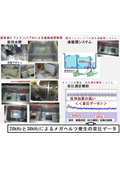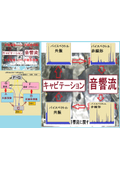A system that controls the emission of two types of ultrasonic probes from a single channel.
Technology for controlling nonlinear phenomena of ultrasound.
The Ultrasonic System Research Institute has developed a technology to control nonlinear ultrasonic phenomena by utilizing the interactions generated from simultaneously oscillating two types of ultrasonic probes from one oscillation channel of a function generator. (Note: Nonlinear (resonance) phenomena refer to the resonance phenomenon of ultrasonic vibrations that occurs due to the generation of harmonics resulting from original oscillation control, achieving high amplitudes through resonance.) By optimizing the ultrasonic propagation characteristics of various materials to suit specific purposes, efficient ultrasonic oscillation control becomes possible. Through the measurement and analysis of sound pressure data from ultrasonic testers, this system technology allows for the dynamic changes of surface elastic waves to be controlled according to their intended use. In practical terms, the use of multiple (two types of) ultrasonic probes for multiple (two types of) oscillations (sweep oscillation, pulse oscillation) generates complex vibration phenomena (original nonlinear resonance phenomena), achieving high sound pressure propagation states at high frequencies, or low frequency propagation states with high sound pressure levels tailored to the desired natural frequency.
Inquire About This Product
basic information
In particular, by optimizing the vibration characteristics and megahertz ultrasound of tanks and pumps, we achieve highly efficient ultrasonic control (propagating through 3000 liters of cleaning solution at 30W output). In applications at the nano level, efficient ultrasonic stimulation for nano manipulation is realized with 1 megahertz ultrasonic oscillation, including frequency variations of over 100 megahertz. This technology is based on the measurement and analysis of sound pressure (nonlinear phenomena) and utilizes the acoustic characteristics and interactions of surface elastic waves and ultrasonic propagation tools, forming a dynamic control system technology for ultrasound. Ultrasonic Probe: Outline Specifications Measurement Range: 0.01 Hz to 200 MHz Oscillation Range: 0.5 kHz to 20 MHz Propagation Control Range: 1 kHz to 900 MHz (analysis confirmation) Materials: Stainless steel, LCP resin, silicon, Teflon, glass... Oscillation Equipment: Example - Function Generator If you are interested, please contact us via email. Ultrasonic Propagation Characteristics 1) Detection of vibration modes (changes in self-correlation) 2) Detection of nonlinear phenomena (changes in bispectrum) 3) Detection of response characteristics (analysis of impulse response) 4) Detection of interactions (analysis of power contribution rates)
Price information
Standard Reference Example Oscillation System 20MHz from 80,000 yen ~ Please feel free to contact us.
Price range
P2
Delivery Time
※Feel free to contact us.
Applications/Examples of results
Specific examples .. 5) Improvement of welding quality through ultrasonic irradiation of welding machines. 6) Relaxation of surface residual stress through ultrasonic irradiation of brazing and bending processing equipment. 7) Improvement of cleaning level through ultrasonic irradiation of ultrasonic cleaning machines. 8) Prevention of aging degradation related to vibration through ultrasonic irradiation of various machine tools. 9) Prevention of internal adhesion through ultrasonic irradiation of piping and pipes. 10) Through ultrasonic irradiation of pipelines: 1: Improvement of internal fluidity. 2: Internal cleaning. 11) Stabilization of rotation through ultrasonic irradiation of rotating devices. 12) Through ultrasonic irradiation of aluminum die-casting equipment: 1: Improvement of aluminum fluidity at high temperatures. 2: Uniformity of temperature changes (uniformity of surface residual stress). 3: Improvement of surface quality. 13) Through ultrasonic irradiation of casting, forging, and other high-temperature systems: 1: Uniformity of temperature changes (uniformity of surface residual stress). 2: Improvement of surface quality. 14) Through ultrasonic irradiation of manufacturing lines and systems: 1: Stabilization of vibration modes (long lifespan). 2: Stabilization of manufacturing quality (e.g., assembly conditions...). 15) Improvement of emulsification and dispersion efficiency. ..
Detailed information
-

A system that controls the emission of two types of ultrasonic probes from a single channel.
-

A system that controls the emission of two types of ultrasonic probes from a single channel.
-

A system that controls the emission of two types of ultrasonic probes from a single channel.
-

A system that controls the emission of two types of ultrasonic probes from a single channel.
-

A system that controls the emission of two types of ultrasonic probes from a single channel.
-

A system that controls the emission of two types of ultrasonic probes from a single channel.
-

A system that controls the emission of two types of ultrasonic probes from a single channel.
-

A system that controls the emission of two types of ultrasonic probes from a single channel.
-

A system that controls the emission of two types of ultrasonic probes from a single channel.
catalog(19)
Download All Catalogs



News about this product(9)
Company information
The Ultrasonic System Research Institute conducts the following activities with its original product: ultrasonic systems (sound pressure measurement analysis, oscillation control): 1) Manufacturing and sales of ultrasonic systems (sound pressure measurement analysis, oscillation control) 2) Consulting services for various equipment (Note): cleaning machines, stirring devices, processing equipment, machine tools, plating devices, welding devices, etc. Ultrasonic System (Sound Pressure Measurement Analysis, Oscillation Control) We manufacture and sell a system that combines the "Ultrasonic Tester NA (recommended type)" for easy measurement and analysis of ultrasonic waves and the "Ultrasonic Oscillation System (1 MHz, 20 MHz)" for easy oscillation control. <Patent Applications Filed> Patent Application No. 2021-125866: Ultrasonic Control (Ultrasonic Oscillation Control Probe) Patent Application No. 2021-159990: Ultrasonic Welding Patent Application No. 2021-161532: Ultrasonic Plating Patent Application No. 2021-171909: Ultrasonic Processing Patent Application No. 2021-175568: Flow-type Ultrasonic Cleaning Some of the manufacturing technology for the ultrasonic oscillation control probe is described in Patent Application No. 2021-125866. Patent Application No. 2023-195514: Ultrasonic Plating Using Megahertz Ultrasonic Waves and Fine Bubbles.




















